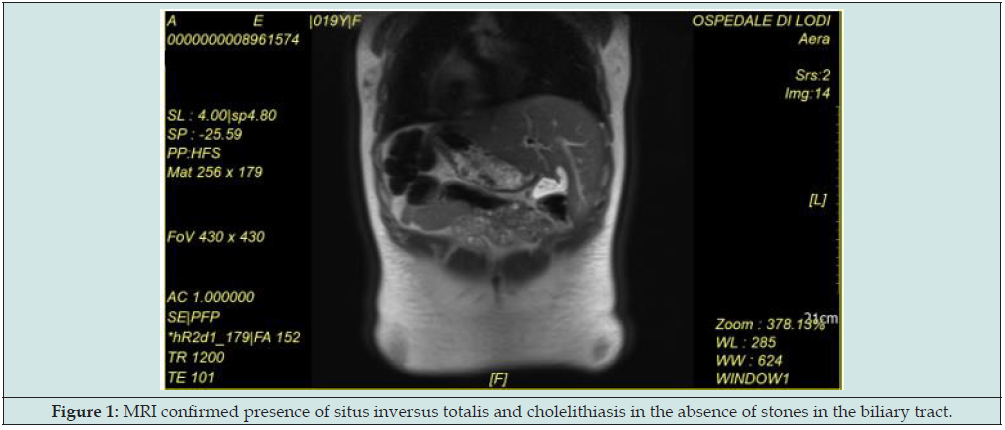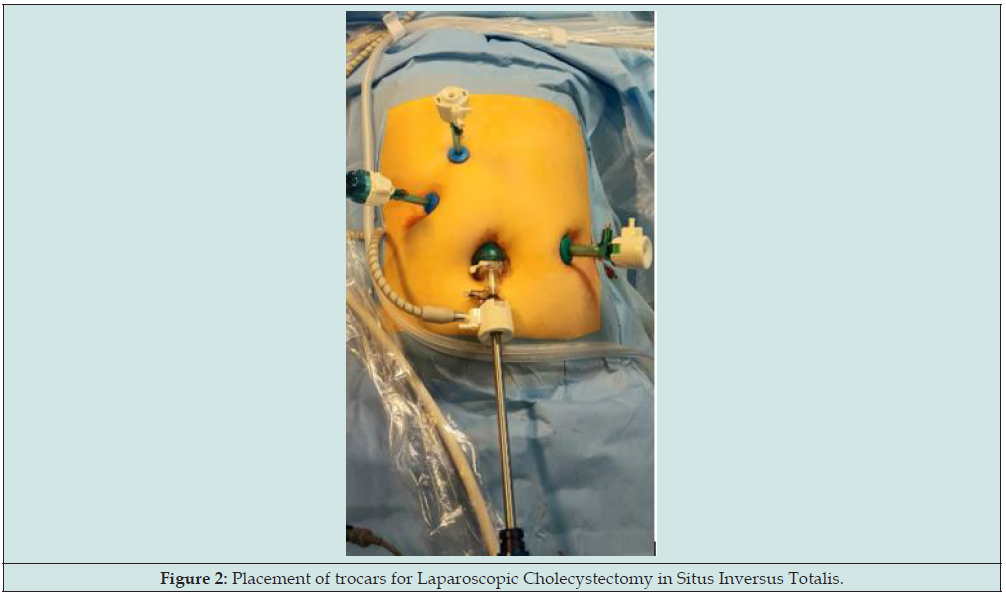
Lupine Publishers Group
Lupine Publishers
Menu
ISSN: 2643-6760
Case Report(ISSN: 2643-6760) 
Laparoscopic Cholecystectomy for Symptomatic Gallstones in Situs Inversus Totalis: A Particular Trocars Placement Volume 7 - Issue 2
Vincenzo Tripodi, Marco Longhi and Pietro Bisagni*
- Department of General Surgery, ASST Lodi, Lodi, Italy
Received:November 23, 2022; Published:December 05, 2022
Corresponding author: Pietro Bisagni, Department of General Surgery, ASST Lodi, Lodi, Italy
DOI: 10.32474/SCSOAJ.2022.07.000258
Abstract
Laparoscopic cholecystectomy is the gold standard for the surgical treatment of symptomatic gallstones, even in patients with situs inversus totalis. This anatomical condition can make the surgical procedure more difficult and challenging; for this reason, it is necessary to have an adequate preoperative strategy concerning the position of the patient and the trocar placement. In this article we present the case of a patient with symptomatic cholelithiasis with situs inversus totalis operated by a right-handed surgeon with a modified trocar placement.
Keywords: Cholecystectomy; Cholelithiasis; Hypochondrium; Mirror Disposition; Biliary Lesions
Abbreviations: CVS: Critical View of Safety; ERCP: Endoscopic Retrograde Cholangiopancreatography
Introduction
Cholelithiasis is a common disease characterized by stone formation in the gallbladder; gallstones may stay asymptomatic or may cause symptoms such as dyspepsia, nausea, or discomfort in the right upper quadrant. Approximately 10% to 20% of the population will develop gallstones at some point in their lifetime, and women are more often affected than men [1]. Laparoscopic cholecystectomy is the gold standard for the treatment of symptomatic cholelithiasis [2] and it can be performed through two different technical approaches: the French technique and the American technique. According to the French technique, the patient is in the lithotomy position with legs abducted and the surgeon standing between patient’s legs. Four trocars are placed: the first 10-mm trocar is inserted in the upper part of the umbilicus, the two 5-mm trocars are placed 1 cm under the right costal margin as far as possible from each other, the fourth trocar (10 mm) is placed under view in the left hypochondrium [3].
In the American technique, the patient is in the supine position with the left arm in abduction and the surgeon stands on the patient’s left side. Four trocars are placed: the first 10-mm trocar is inserted just below the umbilicus, the second 10-mm trocar is inserted below the xiphoid process, while two 5-mm ports are placed along the right costal margin [4]. First laparoscopic cholecystectomy procedures were associated with a high incidence of biliary injuries [5]. The most common cause of severe biliary injury is the misidentification of bile duct. In 1995 was introduced a method of identification of the cystic structures referred to as the “Critical View of Safety” (CVS) [6]. The CVS has three requirements: [6] the triangle of Calot must be cleared of fat and fibrous tissue, the lowest part of the gallbladder must be adequately divided from the cystic plate and only two structures must be seen entering the gallbladder. Once these three criteria have been fulfilled, CVS has been obtained. [6-7] CVS has been shown to reduce the occurrence of serious biliary injuries [7]. Situs inversus totalis is a rare autosomal recessive genetic condition characterized by a complete transposition of thoracic and abdominal organs to the opposite side of the body [8]. With the liver and gallbladder situated on the left side of the abdomen, symptomatic cholelithiasis may be a challenging diagnosis and increase the complexity of the surgical procedure. For this reason, some technical modifications should be performed to have an ergo-dynamic position for the surgeon, obtain a secure CVS and lead to a safer surgical procedure [9].
Case Report
A 19-year-old patient came to our attention complaining about postprandial abdominal pain in the left upper quadrant that had been present for several months. She was diagnosed situs inversus totalis when she was a child. An abdominal ultrasound showed a lithiasis gallbladder on the left side of the abdomen. We decided to treat her surgically with a laparoscopic cholecystectomy. Before the surgery the patient underwent an abdominal magnetic resonance which confirmed the presence of gallbladder stones and showed no anatomical abnormalities of the biliary tract (Figure 1). In relation to the “mirror disposition” of the liver, the operating room was prepared, with the monitor standing on the left side of the operating table. The patient was placed in the supine position, with both arms abducted and the legs closed, and the surgeons stood on the right side of the patient. Four trocars were placed, as shown in (Figure 2).
Figure 1: MRI confirmed presence of situs inversus totalis and cholelithiasis in the absence of stones in the biliary tract.

A 10-mm trocar was placed in supra-umbilical position. The operative 10-mm trocar was placed in the left pararectal site at the level of the umbilicus. Two other 5-mm ports were placed in the subxiphoid region and in the right hypochondrium, 3 cm below the costal margin. The inspection of the abdominal cavity confirmed the situs inversus totalis. The primary surgeon, righthanded, used the dominant hand from the left pararectal trocar, while the first assistant retracted laterally the gallbladder from the right hypochondrium port, allowing an adequate exposition of the Calot’s triangle. Peritoneum and fatty tissue were dissected using hook diathermy, leading to a correct CVS and identification of cystic artery and duct. Both structures were clipped and cut. A retrograde cholecystectomy was performed. Operating time was 44 minutes. No complications occurred during the procedure. The post-operative course was uncomplicated, and the patient went home 24 hours after the surgery.
Discussion
Situs inversus totalis is a rare congenital condition in which the heart and abdominal viscera are present as a mirror image of the normal anatomy. Laparoscopic cholecystectomy is the gold standard for the treatment of symptomatic cholelithiasis [2] but this anatomical condition may lead to technical difficulties performing the surgery, increasing the risk of biliary lesions. It is therefore necessary to correctly place laparoscopic ports to have an ergo-dynamic position for the surgeon, avoiding crossing arms, to perform a safer procedure. M. A. Cha ouch and collaborators published a systematic review of 76 cases of laparoscopic cholecystectomy in situs inversus patients. According to their paper, the right-handed primary surgeon stood on the patient’s right side in 79% of the cases and between patient’s legs in 21% of the cases. When standing on the right side of the operating table, surgeons adopted the “American mirror technique” in 97% and the “French mirror technique” in 3% of cases. In the “American mirror technique”, the surgeon performed the dissection using the right hand from the epigastric port in 26% of procedures and from the left mid-clavicular port in 32% of the surgeries. When standing between the legs of the patient, the “American mirror technique” was chosen in 36% of the cases and the “French mirror technique” in 64%. In the “American mirror technique”, the surgeon performed the dissection from the epigastric port using the left hand or from the midline clavicular port using the right hand.
The left-handed surgeons performed dissection using the left hand by epigastric port using the “American mirror technique”. When the “French mirror technique” was preferred, the dissection was done using the left hand from the right flank port. Operative times were mentioned in 52 cases and the median operative time was 74 minutes (range 30 -240). To compare the operative time of different surgical techniques, the authors excluded the procedures including intraoperative cholangiography and/or ERCP, laparotomic conversion and patients previously operated for an abdominal disease. The “American mirror technique” was used in 33 cases with a median operative time of 64 minutes and the “French mirror technique” was used in 7 cases with a median operative time of 72 minutes. In our center, laparoscopic cholecystectomy is usually performed adopting a mixed approach between the American and the French technique. The monitor is placed on the patient’s right side, and the surgeon stands on the left side of the operating table. Four ports are placed as follows: a 10mm supra-umbilical trocar, a second 10-mm operative trocar in left hypochondrium, two 5-mm ports in epigastrium and right hypochondrium, at the umbilicus level. In this case, the patient was placed in a supine position and four ports were placed as previously described. A right-handed surgeon performed laparoscopic cholecystectomy using the left pararectal port to dissect structures and the right hypochondrium port to retract the Hartmann’s pouch. The first assistant used the epigastrium trocar to retract the gallbladder. Operating time was 44 minutes, lower than the median operative time mentioned in Chaouch’s reviews, and we had no intra-operative complications. A successful CVS was obtained, and biliary structures were correctly identified. Our modified trocar positioning may therefore be considered a safe technique to adopt in patients with situs inversus totalis to allow a safe procedure.
Conclusion
Laparoscopic cholecystectomy is the gold standard for the treatment of symptomatic cholelithiasis even in a challenging condition such as the situs inversus totalis. Due to the anatomical disposition, it is mandatory to have an adequate surgical setting to obtain an ergo-dynamic position for the surgeon and to reach a critical view of safety, reducing the risks of bile duct injuries. In our case we adopted a modified position of the ports allowing the primary surgeon to perform a safe cholecystectomy with adequate operative time and no surgical complications.
References
- Amber Littlefield, Christy Lenahan (2019) Cholelithiasis: Presentation and Management - Journal of Midwifery & Women's Health64(3): 289-297.
- B D Schirmer, S B Edge, J Dix, M J Hyser, J B Hanks, R S Jones (1991) Laparoscopic cholecystectomy. Treatment of choice for symptomatic cholelithiasis - Ann Surg 213(6): 665-676.
- Dubois F (1995) Laparoscopic cholecystectomy: the French technique. Operative strategies in laparoscopic surgery pp. 30-33.
- Carrol Bj (1995) “Laparoscopic Cholecistectomy: The American technique.” Operative strategies in laparoscopic surgery-pp. 30-33.
- Southern Surgeon Club (1991) A Prospective Analysis Of 1518 Laparoscopic Cholecistectomies-N. Engl J Med 324(16): 1073-1078.
- S M Strasberg, M Hertl, N J Soper (1995) An analysis of the problem of biliary injury during laparoscopic cholecystectomy-J Am Coll Surg 180(1): 101-125.
- Steven M, Brunt L, Michael (2017) Critical View of Safety Strasberg 265(3): 464-465.
- Veronica Navarro, Harumi Oshiro, Bruce Peña, Fernando Moquillaza Pineda (2013) Situs inversus totalis-Rev Gastroenterol Peru 33(4): 345-347.
- Mohamed Ali Chaouch, Hichem Jerraya, Mohamed Wejih Dougaz, Ramzi Nouira, Chadli Dziri (2021) A Systematic Review of Laparoscopic Cholecystectomy in Situs Inversus-J Invest Surg 34(3): 324-333.
- Phothong N, Akaraviputh T, Chinswangwatanakul V, Trakarnsanga A (2015) Simplified technique of laparoscopic cholecystectomy in a patient with situs inverus: a case report and review of techniques-BMC Surg 15(1): 23.
- Crosher R, Harnarayan P, Bremner D (1996) Laparoscopic cholecystectomy in situs inversus totalis-R Coll Surg Edinb 41 (3): 183-184.
- Palomba G, Dinuzzi VP, Manigrasso M, Milone M, De Palma G D, Aprea G (2020) Laparoscopic cholecystectomy with a mixed approach in a patient with Kartagener Syndrome: technical report and review of literature -Indian Journal of Surgery 83: 411-417(2021).

Top Editors
-

Mark E Smith
Bio chemistry
University of Texas Medical Branch, USA -

Lawrence A Presley
Department of Criminal Justice
Liberty University, USA -

Thomas W Miller
Department of Psychiatry
University of Kentucky, USA -

Gjumrakch Aliev
Department of Medicine
Gally International Biomedical Research & Consulting LLC, USA -

Christopher Bryant
Department of Urbanisation and Agricultural
Montreal university, USA -

Robert William Frare
Oral & Maxillofacial Pathology
New York University, USA -

Rudolph Modesto Navari
Gastroenterology and Hepatology
University of Alabama, UK -

Andrew Hague
Department of Medicine
Universities of Bradford, UK -

George Gregory Buttigieg
Maltese College of Obstetrics and Gynaecology, Europe -

Chen-Hsiung Yeh
Oncology
Circulogene Theranostics, England -
.png)
Emilio Bucio-Carrillo
Radiation Chemistry
National University of Mexico, USA -
.jpg)
Casey J Grenier
Analytical Chemistry
Wentworth Institute of Technology, USA -
Hany Atalah
Minimally Invasive Surgery
Mercer University school of Medicine, USA -

Abu-Hussein Muhamad
Pediatric Dentistry
University of Athens , Greece

The annual scholar awards from Lupine Publishers honor a selected number Read More...





